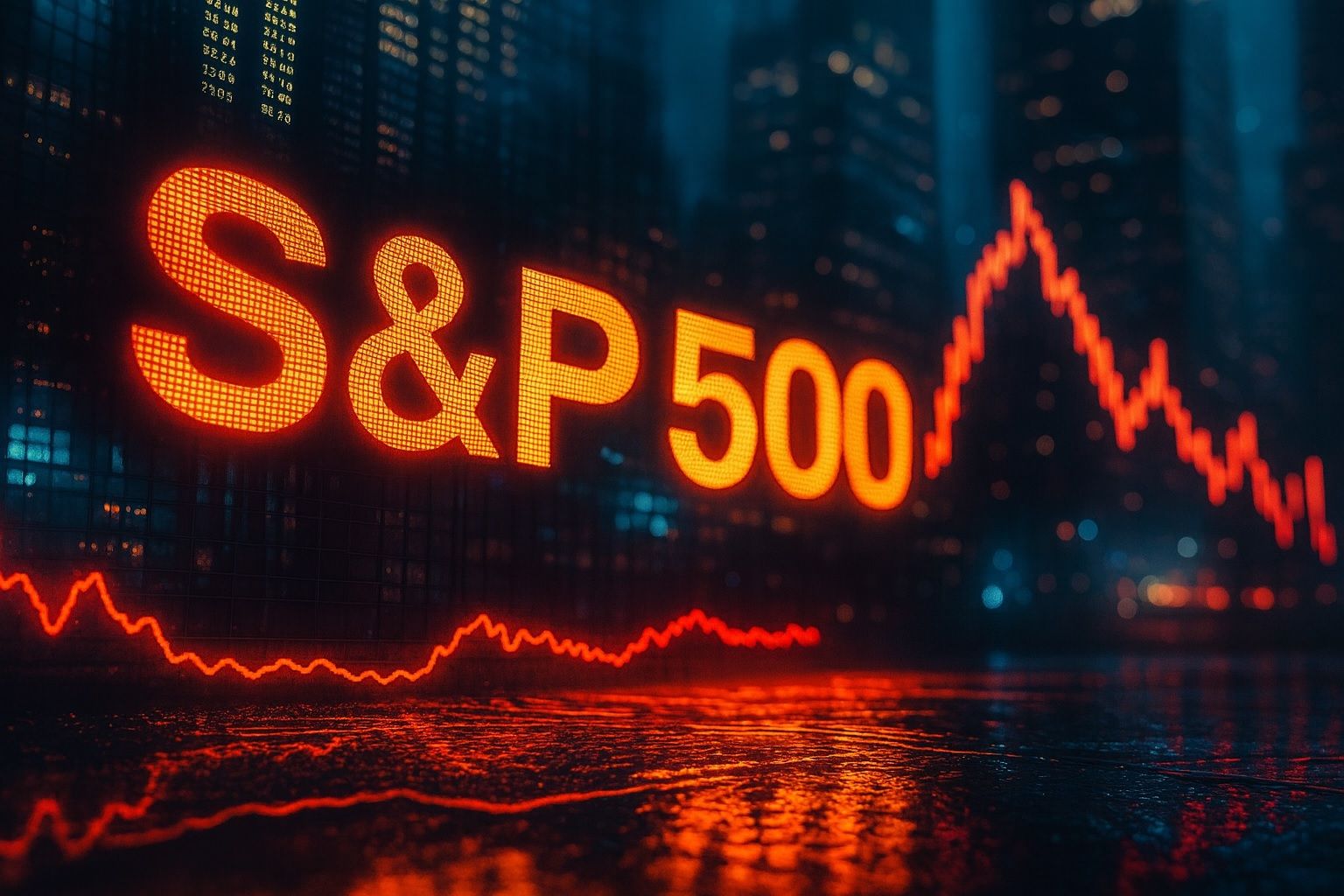- $100B Wiped Out on Bank Jitters: U.S. stocks tumbled on credit fears, wiping out over $100 billion in market value across dozens of bank stocks in a single day [1]. The Dow Jones Industrial Average shed nearly 300–400 points (~0.9%) Thursday, reversing an early rally [2], while the S&P 500 and Nasdaq each fell around 0.7–1% [3]. More than 80% of S&P 500 companies traded down on the day amid a broad flight from risk assets [4].
- Regional Bank Fraud Shocks: The selloff was sparked by surprise loan troubles at two regional lenders. Zions Bancorp disclosed a sudden $50 million charge-off on two commercial loans after uncovering “misrepresentations and irregularities” — essentially an alleged fraud by the borrowers [5]. Its stock plunged 12–13% to multi-month lows. Western Alliance (WAL), a peer bank, sank 10–11% after revealing it had sued a borrower for fraud related to a ~$100 million real estate loan [6]. Although these losses were relatively small in absolute terms, the back-to-back fraud revelations rattled confidence in the banking sector [7].
- Contagion Fears Hit Financials: Investors reacted with “sell first, ask questions later” mentality across financial shares [8]. The KBW Regional Banking Index plunged ~6% Thursday [9], its worst drop since April, as even banks with no direct ties to the incidents sold off on “hidden credit stress” worries [10] [11]. Investment firm Jefferies fell ~10% on worries about its exposure to a recently bankrupt auto lender, First Brands [12]. Volatility spiked – Wall Street’s “fear index” (VIX) jumped about 20% to its highest level since May [13] as credit jitters spread.
- Safe Havens Surge – Gold at Record High: In a classic flight to safety, gold prices rocketed to an all-time high above $4,370/oz [14], surging ~8% this week for the biggest weekly gain since 2008. Investors snapped up U.S. Treasurys, driving yields to multi-year lows: the 2-year Treasury yield plunged to ~3.38% (a three-year low) and the 10-year yield fell under 4% [15]. Traders are now pricing in at least two Federal Reserve rate cuts by year-end as the Fed may “have to ease policy sooner to cushion the economy if credit problems spread” [16] [17].
- ‘Cockroach’ Credit Warnings: Wall Street is debating if these loan fiascos are isolated or the “tip of an iceberg.” JPMorgan CEO Jamie Dimon cautioned this week, “When you see one cockroach, there are probably more,” after revealing his bank took a $170 million hit from a collapsed lender [18]. Analysts note a string of recent credit blowups – from subprime auto lender Tricolor’s fraud-tainted bankruptcy to First Brands’ $10B collapse – have raised concerns that years of easy credit are coming home to roost [19]. “Where there is smoke, there is often fire,” warned IG Markets strategist Tony Sycamore, saying 2023’s quick bank-crisis fixes left “a tinderbox for another banking flare-up” if more problems emerge [20] [21].
Market Selloff Fueled by Loan Fraud Fears
Wall Street skidded into the red late this week as fear of hidden loan losses gripped the market. On Thursday (Oct. 16), the Dow, S&P 500, and Nasdaq all closed sharply lower – around 0.5%–1% down each for the day [22] – after early gains evaporated. The Dow Jones index gave up roughly 300–400 points, about 0.65%, by the closing bell [23]. The reversal came suddenly after midday news of loan problems at two regional banks hit traders’ screens. “Signs of weakness in regional banks spooked investors already on edge,” Reuters noted, especially as U.S.–China trade tensions and other uncertainties were already weighing on sentiment [24].
<small>Regional Bank Revelations Trigger Selloff.</small> Zions Bancorporation (NASDAQ: ZION), a Utah-based regional lender, stunned investors by announcing an unexpected loan loss in an SEC filing late Wednesday. The bank found that two large commercial-and-industrial loans – totaling about $60 million – were likely fraudulent: borrowers had misrepresented collateral and defaulted, prompting Zions to write off $50 million immediately [25]. “The optics of a large C&I loan to a fraudulent borrower from a bank that specializes in small C&I loans is not great,” observed analysts at Raymond James, questioning how such a rogue deal slipped through Zions’ risk controls [26] [27]. Zions typically lends to small and mid-sized businesses, so this outsized bad loan raised a red flag. The bank’s swift charge-off and lawsuit to recover funds did little to calm investors – ZION stock plunged ~13% on Thursday, its worst drop in six months, wiping out roughly $600–700 million of market value [28] [29]. The share price sank into the high $40s (multi-month lows), and “an uneventful morning rally on Wall Street abruptly reversed” once the Zions news broke [30].
Almost simultaneously, Western Alliance Bancorp (NYSE: WAL) revealed it was entangled in a related fiasco. The Phoenix-based bank didn’t lend alongside Zions, but had exposure to a similar borrower – and in fact had already filed a fraud lawsuit back in August against that borrower [31]. In Western Alliance’s case, an entity called Cantor Group V LLC allegedly forged real estate loan documents to obtain a ~$100 million credit line [32]. Western Alliance’s management insists it has sufficient collateral and guarantees to cover the loan [33] and noted the problematic loan was identified early, with no losses booked yet. But merely being caught in another fraud scenario shook confidence in WAL. Its stock tumbled about 10–11% Thursday to around $70 per share [34] [35]. The late-week carnage left Western Alliance down nearly 28% from its 52-week high, erasing a relief rally it enjoyed just days prior [36].
Other financial names felt the fallout. Even banks with no direct link to the fraud cases sold off as investors asked “what else might be lurking?” [37]. The SPDR Regional Banking ETF dropped 6.1% in its steepest one-day fall since April [38]. Ohio-based Fifth Third Bancorp – which last month disclosed up to a $200 million loan loss from suspected fraud on two loans – fell another 4% [39]. And investment bank Jefferies Financial Group sank about 9–10%, as traders remembered Jefferies had sizeable exposure to First Brands Group, a major auto-parts supplier that went bankrupt in September [40] [41]. In other words, a handful of “one-off” credit blow-ups proved enough to ignite a broader panic in a market already cautious about the credit cycle.
“I think there’s some nervousness associated with the credit markets,” said Ron Albahary, chief investment officer at LNW in Philadelphia, noting that seasoned traders know “you don’t ignore anything that might be a yellow flag” once credit red flags emerge [42]. With benchmark stock indices near record highs prior to this scare, investors were quick to “sell first and ask questions later” at any hint of trouble [43].
Flight to Safety: Gold Soars, Yields Plunge
As bank stocks swooned, fear-driven money rushed into safe havens. Gold prices exploded to record levels, briefly trading above $4,379 per ounce on Friday – the highest price ever [44]. The precious metal is up roughly 8% this week, on track for its biggest weekly jump since the 2008 financial crisis [45]. “The flight to safety saw gold hit a record … a frenzy,” one report noted [46] [47]. Investors are hoarding gold as a hedge: “It wouldn’t surprise me if gold hits $5,000 before it stops for air,” said Eren Osman of Arbuthnot Latham, though he warned this run-up could be volatile [48].
U.S. Treasury bonds also rallied fiercely. Yields, which move opposite prices, plummeted to multi-year lows amid the dash for security. The 10-year Treasury yield sank below 4.0% – its lowest level of 2025 [49] – after hovering near post-pandemic highs earlier this month. The policy-sensitive 2-year yield dived to about 3.38%, a level not seen in three years [50]. These sharp moves reflect a growing bet that the Federal Reserve will cut interest rates sooner-than-planned if credit stress threatens the economy [51]. In fact, futures markets are now fully pricing in at least one Fed rate cut by the Fed’s October meeting (and potentially more by year-end) [52] [53]. This marks a rapid shift in expectations – just weeks ago, investors were debating if the Fed would raise rates again, not cut. Now, “traders believe the Fed will have to ease policy sooner to cushion the economy if credit problems spread,” as Reuters observed [54] [55].
The rush into safe assets was global. In currency markets, traditional havens like the Japanese yen and Swiss franc each jumped ~1% against the dollar [56]. In the U.S., demand for short-term cash safety spiked so much that usage of the Fed’s overnight repo facility hit extreme levels – a sign banks and funds are stashing liquidity for protection [57] [58]. All told, late this week saw a textbook “risk-off” pattern: stocks down, volatility up, gold up, yields down [59].
Global Ripples and Trade Tensions
By Friday Oct. 17, the turmoil had spread beyond Wall Street. Asian markets fell overnight after watching U.S. bank shares tank. Japan’s Nikkei 225 slid about 1.6%, and Hong Kong’s Hang Seng dropped ~2% [60]. Those losses carried into Europe, where bank stocks opened in freefall. The pan-European STOXX 600 index ended Friday down ~1.8%, led by a 2.7% plunge in the Euro Stoxx Banks index [61]. Major European lenders like Deutsche Bank and Barclays saw their shares sink over 5% amid the contagion [62]. “What we see is banks selling off overnight in the U.S., Asia wakes up to it, Europe wakes up to it, and so it spreads,” explained James Rossiter, head of global macro strategy at TD Securities [63]. In other words, once credit fear sparked in one region, it quickly ricocheted worldwide as trading desks across time zones reacted.
To make matters worse, these financial jitters coincided with other clouds on the horizon. U.S.–China trade tensions have been escalating, adding another layer of market anxiety. Beijing recently announced export curbs on critical rare earth minerals, retaliating amid a renewed trade spat [64]. In response, U.S. President Donald Trump threatened 100% tariffs on Chinese goods starting Nov. 1 – a dramatic step that has investors worried about global growth [65] [66]. “The added uncertainty of U.S.-China trade and increased rhetoric … is adding to market instability,” noted Tom Hainlin, a strategist at U.S. Bank Wealth Management [67].
Meanwhile in Washington, a federal government shutdown has halted official economic reports, leaving investors to fly partly blind on data [68]. The timing couldn’t be worse: with key indicators delayed, markets have even less clarity just as volatility surges. Robust Q3 earnings from big U.S. banks (JPMorgan, Bank of America, etc.) earlier in the week had painted a picture of resilience [69] [70], but those positive signals are being overshadowed by the sudden credit scare.
Experts Debate: One-Off Problems or Tip of the Iceberg?
A crucial question now hangs over the market: Are these bank loan fiascos isolated blunders or warning signs of systemic credit weakness? Bank executives and many analysts maintain that the issues appear idiosyncratic so far. Zions’ management insisted the $50M fraud loss is “an isolated case” and even hired outside investigators to confirm it’s not part of a wider problem [71]. Executives at Western Alliance likewise emphasize that one rogue borrower is at fault, not a broader deterioration in credit quality [72] [73]. Big banks seem relatively unfazed as well – despite JPMorgan’s precautionary reserve boost tied to the auto-loan bust, the top five U.S. banks collectively set aside the smallest loan-loss reserves in two years last quarter [74]. That signals that major lenders “aren’t bracing for a credit apocalypse” [75] in the view of their risk teams.
Optimists also point out that the economy is still growing modestly and corporate earnings have been coming in solid. The S&P 500 is up about 12% in 2025 so far [76], and many on Wall Street view this pullback as a potentially healthy correction from lofty valuations (the S&P was trading at ~23× earnings, a five-year high) [77]. “The bull market remains intact,” argue some strategists who see dips like this as buying opportunities if fundamentals haven’t changed [78]. In short, they believe the economy “may bend but not break” despite the current jitters [79] – assuming no larger shoes drop.
However, skeptics warn against complacency. The emergence of multiple “one-off” credit events in quick succession has clearly rattled the market. “While these events spook markets, they also reinforce the need for vigilance,” wrote Morningstar’s Frank Scarso, noting that even if each incident is isolated, together they hint at rising credit strain in pockets of the system [80]. The “cockroach theory” cited by Jamie Dimon – that one seen implies many unseen – is on everyone’s mind [81]. Indeed, the recent cases share a common theme: they’re not just normal loan defaults from a slow economy, but involve alleged malfeasance and poor oversight in niche lending areas [82] [83]. That raises concern that certain corners of the credit market (e.g. private lenders, subprime finance, or commercial real estate) might be riskier than they appear on banks’ balance sheets. “In times of loose credit, you are going to have more instances of fraud,” one expert noted, adding that overall “credit is fine, but there’s a heightened need to watch” these outlier cases closely [84].
Looking Ahead: Fed Moves and Market Outlook
The next couple of weeks will be critical for restoring confidence. Both impacted regional banks will speak to investors soon: Zions reports earnings on Oct. 20, and Western Alliance on Oct. 21 [85]. Those calls give management a chance to explain what happened and convince the market that these were singular events. “Zions faces the challenge of showing this is a one-off and not a broader weakness,” said Zacks analyst Brian Mulberry ahead of the results [86]. Wall Street will also be watching if other banks disclose any similar credit surprises in their earnings. Thus far, the consensus view is cautiously optimistic – for instance, 13 out of 14 analysts covering Western Alliance still rate it a “Buy”, and its average price target near $103 is about 30% above current levels [87] [88]. That bullish outlook suggests many see the recent plunge as overdone if no new issues emerge.
On the policy front, attention turns to the Federal Reserve. Fed Chair Jerome Powell has signaled openness to another quarter-point rate cut as soon as this month [89] [90], especially if financial conditions tighten due to these banking strains. Lower rates would relieve pressure on borrowers and banks (who have been squeezed by higher funding costs), so any hint of a Fed backstop could help soothe markets. In fact, traders are speculating that if turbulence continues, the Fed “may be forced to cut rates sooner” than previously thought [91].
For now, markets are likely to remain choppy and headline-driven. “Credit concerns have put the market in de-risking mode,” one strategist observed [92], noting that even strong earnings are being overshadowed by the hunt for any lurking loan problems. Further shocks – another bank disclosure, a credit fund blow-up, etc. – could extend the selloff. Absent that, a period of calmer trading and reassuring earnings commentary could allow stocks to stabilize and resume their upward trajectory.
Many analysts still believe we are not on the verge of a 2008-style crisis. “Big banks can fairly easily absorb charge-offs of this size,” Mr. Dimon said, contrasting JPMorgan’s ability to swallow hits like Tricolor’s loans with the more fragile position of smaller regional lenders [93] [94]. In other words, the financial system’s core is strong, and these are manageable setbacks. The most likely scenario, in the view of several market veterans, is that the economy and markets “bend but don’t break” – a temporary bout of volatility rather than a full-blown meltdown [95]. But as this week has shown, confidence is a fickle thing. Investors and regulators will be on high alert for any additional cockroaches in the credit cupboard in the days ahead.
Sources: CNBC [96] [97], Yahoo Finance [98] [99], CNN [100] [101], TS2.tech [102] [103], Reuters [104] [105], Times of India [106] [107], MarketMinute/WRAL [108] [109].
References
1. ts2.tech, 2. ts2.tech, 3. ts2.tech, 4. ts2.tech, 5. ts2.tech, 6. ts2.tech, 7. ts2.tech, 8. ts2.tech, 9. ts2.tech, 10. ts2.tech, 11. ts2.tech, 12. ts2.tech, 13. ts2.tech, 14. ts2.tech, 15. ts2.tech, 16. ts2.tech, 17. ts2.tech, 18. ts2.tech, 19. ts2.tech, 20. ts2.tech, 21. ts2.tech, 22. www.reuters.com, 23. www.reuters.com, 24. www.reuters.com, 25. ts2.tech, 26. ts2.tech, 27. ts2.tech, 28. ts2.tech, 29. ts2.tech, 30. ts2.tech, 31. ts2.tech, 32. ts2.tech, 33. markets.financialcontent.com, 34. ts2.tech, 35. ts2.tech, 36. ts2.tech, 37. ts2.tech, 38. markets.financialcontent.com, 39. markets.financialcontent.com, 40. markets.financialcontent.com, 41. ts2.tech, 42. www.reuters.com, 43. ts2.tech, 44. ts2.tech, 45. ts2.tech, 46. ts2.tech, 47. ts2.tech, 48. ts2.tech, 49. ts2.tech, 50. ts2.tech, 51. ts2.tech, 52. ts2.tech, 53. ts2.tech, 54. ts2.tech, 55. ts2.tech, 56. ts2.tech, 57. ts2.tech, 58. ts2.tech, 59. ts2.tech, 60. ts2.tech, 61. ts2.tech, 62. ts2.tech, 63. ts2.tech, 64. ts2.tech, 65. www.reuters.com, 66. www.reuters.com, 67. www.reuters.com, 68. www.reuters.com, 69. ts2.tech, 70. ts2.tech, 71. ts2.tech, 72. ts2.tech, 73. ts2.tech, 74. ts2.tech, 75. ts2.tech, 76. www.reuters.com, 77. www.reuters.com, 78. ts2.tech, 79. ts2.tech, 80. www.morningstar.com, 81. ts2.tech, 82. ts2.tech, 83. ts2.tech, 84. ts2.tech, 85. ts2.tech, 86. ts2.tech, 87. ts2.tech, 88. ts2.tech, 89. timesofindia.indiatimes.com, 90. timesofindia.indiatimes.com, 91. ts2.tech, 92. ts2.tech, 93. ts2.tech, 94. ts2.tech, 95. ts2.tech, 96. www.reuters.com, 97. www.reuters.com, 98. ts2.tech, 99. ts2.tech, 100. ts2.tech, 101. ts2.tech, 102. ts2.tech, 103. ts2.tech, 104. www.reuters.com, 105. ts2.tech, 106. timesofindia.indiatimes.com, 107. timesofindia.indiatimes.com, 108. markets.financialcontent.com, 109. markets.financialcontent.com










